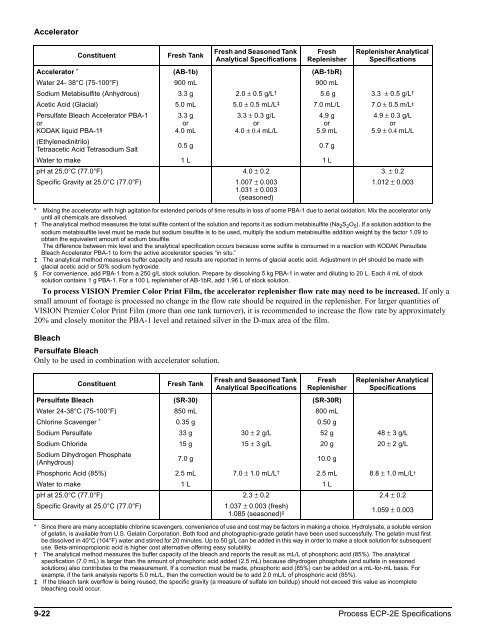Process ECP-2E Specifications - Kodak
Process ECP-2E Specifications - Kodak
Process ECP-2E Specifications - Kodak
Create successful ePaper yourself
Turn your PDF publications into a flip-book with our unique Google optimized e-Paper software.
Accelerator<br />
Constituent Fresh Tank<br />
To process VISION Premier Color Print Film, the accelerator replenisher flow rate may need to be increased. If only a<br />
small amount of footage is processed no change in the flow rate should be required in the replenisher. For larger quantities of<br />
VISION Premier Color Print Film (more than one tank turnover), it is recommended to increase the flow rate by approximately<br />
20% and closely monitor the PBA-1 level and retained silver in the D-max area of the film.<br />
Bleach<br />
Persulfate Bleach<br />
Only to be used in combination with accelerator solution.<br />
Fresh and Seasoned Tank<br />
Analytical <strong>Specifications</strong><br />
Fresh<br />
Replenisher<br />
Replenisher Analytical<br />
<strong>Specifications</strong><br />
Accelerator *<br />
(AB-1b) (AB-1bR)<br />
Water 24- 38°C (75-100°F) 900 mL 900 mL<br />
Sodium Metabisulfite (Anhydrous) 3.3 g 2.0 ± 0.5 g/L †<br />
5.6 g 3.3 ± 0.5 g/L †<br />
Acetic Acid (Glacial) 5.0 mL 5.0 ± 0.5 mL/L ‡<br />
Persulfate Bleach Accelerator PBA-1<br />
or<br />
KODAK liquid PBA-1 §<br />
(Ethylenedinitrilo)<br />
Tetraacetic Acid Tetrasodium Salt<br />
3.3 g<br />
or<br />
4.0 mL<br />
3.3 ± 0.3 g/L<br />
or<br />
4.0 ± 0.4 mL/L<br />
7.0 mL/L 7.0 ± 0.5 m/L ‡<br />
4.9 g<br />
or<br />
5.9 mL<br />
0.5 g 0.7 g<br />
4.9 ± 0.3 g/L<br />
or<br />
5.9 ± 0.4 mL/L<br />
Water to make 1 L 1 L<br />
pH at 25.0°C (77.0°F) 4.0 ± 0.2 3. ± 0.2<br />
Specific Gravity at 25.0°C (77.0°F) 1.007 ± 0.003<br />
1.031 ± 0.003<br />
(seasoned)<br />
1.012 ± 0.003<br />
* Mixing the accelerator with high agitation for extended periods of time results in loss of some PBA-1 due to aerial oxidation. Mix the accelerator only<br />
until all chemicals are dissolved.<br />
† The analytical method measures the total sulfite content of the solution and reports it as sodium metabisulfite (Na2S2O5). If a solution addition to the<br />
sodium metabisulfite level must be made but sodium bisulfite is to be used, multiply the sodium metabisulfite addition weight by the factor 1.09 to<br />
obtain the equivalent amount of sodium bisulfite.<br />
The difference between mix level and the analytical specification occurs because some sulfite is consumed in a reaction with KODAK Persulfate<br />
Bleach Accelerator PBA-1 to form the active accelerator species “in situ.”<br />
‡ The analytical method measures buffer capacity and results are reported in terms of glacial acetic acid. Adjustment in pH should be made with<br />
glacial acetic acid or 50% sodium hydroxide.<br />
§ For convenience, add PBA-1 from a 250 g/L stock solution. Prepare by dissolving 5 kg PBA-1 in water and diluting to 20 L. Each 4 mL of stock<br />
solution contains 1 g PBA-1. For a 100 L replenisher of AB-1bR, add 1.96 L of stock solution.<br />
Constituent Fresh Tank<br />
Fresh and Seasoned Tank<br />
Analytical <strong>Specifications</strong><br />
Fresh<br />
Replenisher<br />
Replenisher Analytical<br />
<strong>Specifications</strong><br />
Persulfate Bleach (SR-30) (SR-30R)<br />
Water 24-38°C (75-100°F) 850 mL 800 mL<br />
Chlorine Scavenger *<br />
0.35 g 0.50 g<br />
Sodium Persulfate 33 g 30 ± 2 g/L 52 g 48 ± 3 g/L<br />
Sodium Chloride 15 g 15 ± 3 g/L 20 g 20 ± 2 g/L<br />
Sodium Dihydrogen Phosphate<br />
(Anhydrous)<br />
7.0 g 10.0 g<br />
Phosphoric Acid (85%) 2.5 mL 7.0 ± 1.0 mL/L †<br />
2.5 mL 8.8 ± 1.0 mL/L †<br />
Water to make 1 L 1 L<br />
pH at 25.0°C (77.0°F) 2.3 ± 0.2 2.4 ± 0.2<br />
Specific Gravity at 25.0°C (77.0°F) 1.037 ± 0.003 (fresh)<br />
1.085 (seasoned) ‡<br />
1.059 ± 0.003<br />
* Since there are many acceptable chlorine scavengers, convenience of use and cost may be factors in making a choice. Hydrolysate, a soluble version<br />
of gelatin, is available from U.S. Gelatin Corporation. Both food and photographic-grade gelatin have been used successfully. The gelatin must first<br />
be dissolved in 40°C (104°F) water and stirred for 20 minutes. Up to 50 g/L can be added in this way in order to make a stock solution for subsequent<br />
use. Beta-aminopropionic acid is higher cost alternative offering easy solubility.<br />
† The analytical method measures the buffer capacity of the bleach and reports the result as mL/L of phosphoric acid (85%). The analytical<br />
specification (7.0 mL) is larger than the amount of phosphoric acid added (2.5 mL) because dihydrogen phosphate (and sulfate in seasoned<br />
solutions) also contributes to the measurement. If a correction must be made, phosphoric acid (85%) can be added on a mL-for-mL basis. For<br />
example, if the tank analysis reports 5.0 mL/L, then the correction would be to add 2.0 mL/L of phosphoric acid (85%).<br />
‡ If the bleach tank overflow is being reused, the specific gravity (a measure of sulfate ion buildup) should not exceed this value as incomplete<br />
bleaching could occur.<br />
9-22 <strong>Process</strong> <strong>ECP</strong>-<strong>2E</strong> <strong>Specifications</strong>
















